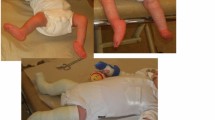Summary
The authors discuss the frequency, etiology, clinical symptomatology, classification, and treatment of congenital dislocations of the knee joint. They present 8 cases of their own material. The congenital knee joint dislocation can be treated conservatively with good results. Treatment with plaster casts does not interfere with treatment of simultaneous hip dysplasias in Pavlik bandages. Even foot deformities can be treated at the same time. They emphasise the need for earliest treatment which seems equally important for all three deformities: knee joint dislocations, hip dysplasias, and club feet.
Zusammenfassung
Autoren erörtern die Häufigkeit, Ätiologie, klinische Symptome, Klassifikation und Behandlung der angeborenen Knieverrenkung, dann beschreiben sie ihre 8 Fälle. Sie stellen fest, daß die kongenitale Knieverrrenkung durch konservative Frühbehandlung gut zu beeinflussen ist. Die mit Gipsverband durchgeführte Etappe-Redression hindert die funktionelle Behandlung der Hüftverrenkung durch Riemenbügel nach Pavlik nicht, sogar die angeschlossenen Fußdeformitäten sind parallel zu korrigieren. Sie betonen die Notwendigkeit der sog. „Frühestbehandlung“, die bei allen drei Veränderungen (Knieverrenkung, Hüftverrenkung, Klumpfuß) eine äußerst große Bedeutung hat.
Similar content being viewed by others
Literatur
Barta, O.: Kombinierte funktionelle Behandlung der angeborenen Hüftverrenkung im Alter von über einem Jahr. Z. Orthop. 101, 219 (1966)
Barta, O., Bellyei, Á., Kránicz, J.: Über das Larsen-Syndrom. Orvosi Hetilap 114, 2723 (1973)
Böhm, M.: Infantile deformities of the knee and hip. J. Bone Jt. Surg. 15, 574 (1933)
Browne, D.: Congenital Deformities of Mechanical Origin. Arch. Dis. Childhood 30, 37 (1955)
Curtis, B. H., Fisher, R. L.: Congenital Hyperextension with Anterior Subluxation of the Knee. J. Bone Jt. Surg. 51-A, 255 (1969)
Czeizel, A., Szentpétery, J., Kellermann, M.: Congenital Dislocation of the Hip in Budapest. Brit. J. Perv. Soc. Med. 28, 265 (1974)
Dowd, C. N.: Congenital Dislocations of Both Knee-Joints. Ann. Surg. XXIX, 345 (1899)
Drehmann, G.: Die congenitalen Luxationen des Kniegelenks. Z. Orthop. 7, 459 (1900)
Finder, J. G.: Congenital Hyperextension of the Knee. J. Bone Jt. Surg. 46-B, 783 (1964)
Forgon, M., Szentpétery, J.: Über angeborene Kniegelenksverrenkung. Arch. Orthop. 52, 599 (1961)
Hass, J., Hass, R.: Arthrochalasis Multiplex Congenita. J. Bone Jt. Surg. 40-A, 663 (1958)
Hussein, M. K.: Multiple Congenital Dislocation. J. Bone Jt. Surg. 20, 488 (1938)
Kaiser, É., Weisenbach, J., Rubecz, I., Ötvös, I., Bodor, A.: Angeborene Kniegelenks-verrenkung im Neugeborenenalter. Orvosi Hetilap 115, 2539 (1974)
Katz, M. P., Grogono, B. J. S., Soper, K. C.: The Etiology and Treatment of Congenital Dislocation of the Knee. J. Bone Jt. Surg. 49-B, 112 (1967)
Kopits, E.: Beiträge zur Pathologie und Therapie der angeborenen Kniegelenkssubluxationen. Arch. Orthop. 23, 593 (1925)
Laurence, M.: Genu Recurvatum Congenitum. J. Bone Jt. Surg. 49-B, 121 (1976)
McFarland, B. L., Orth, M. C.: Congenital Dislocation of the Knee. J. Bone Jt. Surg. 11, 281 (1929)
McFarlane, A. L.: A report on Four Cases of Congenital Genu Recurvatum Occuring in One Family. Brit. J. Surg. 34, 388 (1947)
McKusick, V. A.: Heritable Disorders of Connective Tissue. 4th ed. Saint Louis: C. V. Mosby Company 1972
Middleton, D. S.: Studies on Prenatal Lesions of Striated Muscle as a Cause of Congenital Deformity. Edinburgh Med. J. 401 (1934)
Niebauer, J. J., King, D. E.: Congenital Dislocation of the Knee. J. Bone Jt. Surg. 42-A, 207 (1960)
Pankratiew, B. E.: Luxatio Genus congenita bilateralis per Rotationem. Arch. Orthop. 29, 530 (1931)
Provenzano, R. W.: Congenital Dislocation of the Knee. New Engl. J. Med. 360 (1947)
Szabó, L., Perjés, K.: Gemeinsames Vorkommen kongenitaler Luxationen der großen Gelenke, multiplexer Knochensystemanomalien und einer charakteristischen Physiognomie (Larsen-Syndrom). Magyar Traumat. 17, 37 (1974)
Vartan, C. K.: Cause of Breech Presntation. Lancet 1940 I, 595
Wynne-Davies, R.: Family Studies and the Cause of Congenital Club Foot. J. Bone Jt. Surg. 46-B, 445 (1964)
Wynne-Davies, R.: Heritable Disorders in Orthopaedic Practice, pp. 202. Oxford: Blackwell Sci. Publ. 1973
Author information
Authors and Affiliations
Rights and permissions
About this article
Cite this article
Bellyei, A., Kránicz, J. Die kongenitale Knieverrenkung. Arch orthop Unfall-Chir 87, 51–63 (1977). https://doi.org/10.1007/BF00416139
Received:
Issue Date:
DOI: https://doi.org/10.1007/BF00416139




